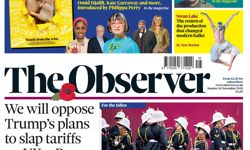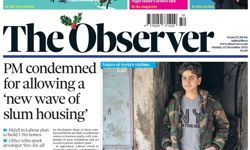The Week is an unusual magazine in British publishing. The vast majority of its circulation is made up of subscribers. It is a slender publication too; just 35 pages of editorial, put together by distilling the best opinions and writing from the world's media. Since its launch in 1995, it has grown every year to its current audited circulation of 187,503 and is poised to record its 28th consecutive audited increase in August. Over the last decade, it's difficult to think of many other consumer titles that have consistently grown their print reach by as much, or as often. This also makes it something of an anomaly in British publishing. That print publishing is doomed to decline is considered an orthodox position these days, yet here is a quirky title that summarises the news in a modest format continuing to grow and demonstrate the power of print in forging strong relationships with consumers.
Tentative first steps online
The title is also something of an oddity in its approach to consumer digital publishing. The Week launched an online news site back in 1999, in the first wave of digital publishing during Web 1.0's heyday. The only content on the site was the magazine, copied and pasted. We were at the time, and continue to be, paranoid about the thought that consumers might believe they could read the print content consistently for free, so we introduced a print subscription paywall and metered access. A web user either had to login using their print subscription details, or else they could read a couple of pages before registration was enforced. If the user wanted to carry on reading, then they were forced to take out a print subscription or the site would stop serving content. Our approach was regarded with a little disdain by some of our digital peer group, who emphasised that we were rather missing the point of the web and that content demanded to be free. The site carried on for a couple of years, and was closed due to the lack of advertising traction and cost. To be honest, I think we felt it was a bit of a distraction to the more serious commercial imperatives of getting print subscribers and selling print advertising. The magazine's circulation would have been around the 50,000 mark then.
Although we put digital content to one side for the best part of a decade, we didn't stop working in the digital sphere. We invested, tested and grew our digital marketing presence. We experimented with keyword and search marketing, affiliates, website display ads, lead generation, email and multivariate web offers. The upshot of this work and investment was that, in 2011, over half of all our print subscribers were recruited through online sources. It is our single most important channel, and continues to grow.
The iPad opportunity
The iPad's launch was the catalyst for the Week to start the process of developing a digital content strategy. For the first time, there was a mass-market digital delivery device that had a payment gateway at its heart and consumers were using it enthusiastically. Magazine and newspaper publishers began to launch their own apps on the iPad. These ranged from more radical efforts like the Daily to simpler PDF page-turners. Previous attempts had been made to create micro-payment hubs on the web, but all of these had either stalled or collapsed. The radical simplicity of the iPad and the focus users bought to their engagement was clearly appealing to the Week. We also began to hear from our customers, asking when the magazine would appear on iPad.
Platform choices
The project of developing the app took about twelve months in total; after some serious thought and product experimentation, the actual build and launch process took about five months. We identified three different technical platform types. The first was a simple PDF recreation of the Week. It would look just like the print magazine, with pinch and zoom functionality. We rejected this as too limited for our brand, although we did put the Week on Zinio - something I would recommend all print publications do; it widens your reach and generates incremental revenue. The second route was to use third party publishing software like Mag+ or Adobe DPS. We rejected these platforms too, mostly for reasons of convenience and workflow. We were keen that the production of the app would not mean the creation of a secondary production and design team, separate from the print team.
The final option was to build a bespoke system, where we controlled our own technical future. Although this was the most expensive option for initial investment, we felt it would pay off in running costs and editions on other platforms. We wrote a technical specification document and went to market. After some very detailed and intensive pitching from about four agencies, we selected a start-up London agency called Kaldor. We used their HTML5 publishing tool, PugPig, to act as the technical base of the app build. This part of the process took much longer than we expected, and led to quite a few internal logjams, but the initial work we put into creating and understanding the technical side of the app was rewarded.
We also commissioned Kaldor to build us a multiplatform CMS for all our content. The creation of the Week, as a magazine app, now takes one editor about 6-7 hours, using this system. There is no redesign work or layout; the content flows from our print title into the CMS and is checked. Lastly, because the app is largely HTML5, an issue’s size is less than 10mb so downloads are very quick and easy.
Presentation issues
A major hurdle was trying to work out just how to lay out the content on the small screen of an iPad, and make it usable. We knew the app had to reflect the magazine's type density and sense of quirk, but provide the digital usability and clarity the medium demanded. Although just 35 pages long, the magazine has over 140 different articles with varying lengths of between just 20 to 350-400 words. Although we didn’t choose Adobe DPS as our final platform choice, it did provide an excellent way of testing different looks and interfaces. We began to experiment, but mostly we got it wrong. What we showed to readers was okay, but lacked some magic and an intuitive interface.
In the end, we decided to have the process facilitated and managed by an external UX (User Experience) agency called Clearleft. Their approach was to build an iterative framework that began by internal interviewing all our stakeholders, running across editorial, advertising, digital and marketing, talking to our readers and analysing our competitors. A project room was created to put ideas on the wall, and various approaches were tried. Once we felt sufficiently confident with the general direction, Clearleft spent a day running individual reader interviews to test the editorial structure and product flow. These interviews were videoed. These videos allowed us to identify a number of UX issues that were corrected in the subsequent version. We then tested this version with a new set of reader interviews to check we’d sorted out the problems.
We learnt quite quickly in the process that nearly every decision we made had a technical impact on the timeline and cost of the launch. To coordinate the process, we formed a project team that met weekly to discuss the product, subscriptions / marketing, technical, and advertising areas. This intensive way of working was essential to the build of the app. There were just so many assumptions, interdependencies and risks involved in such a complex project. We also used internal social networking tools to communicate through the day.
Commercial opportunities
Rather than attempt to sell individual advertising pages or online impressions, we decided to create some extensive advertiser programs for an exclusive group of clients that would last several months. Our lead partner was Rolex, for whom we created a bespoke Daily Briefing section for the app and website. Interactive advertising was also created specifically that demonstrated certain watch features. We had further support from Jaguar and American Express. All of our partnerships were cross-platform, across our online site, iPad app and magazine. Our partnership program enabled us to offer magazine downloads free of charge for the first three months, increasing sampling and awareness.
Subscriber integration
The subscriber integration, service and system were key to building a successful app. Most user complaints about magazine apps tend to be about either stability or identification issues. Subscriber journeys were plotted out, and a marketing plan was drawn up to promote usage. We then sat down with Dovetail, our subscription bureau, to plot out the technical issues.
Prior to launch, we went through three ‘live’ production processes of building an issue to double check that everything worked. The app launched on the 19th November 2011, on the same day that we launched our daily new site TheWeek.co.uk. By the end of April, we had notched up 106,000 downloads of the UK app. The Week went to number one on the iPad charts for news in five countries, and was in the top five in thirty eight territories. An identikit version of the app was created for the US edition, with further partnership from Rolex, and launched in February. American downloads were approaching 200,000 by April. Subscriber and user feedback through iTunes, and direct contact, has been uniformly excellent. 65% of our iTunes ratings have been 5 stars, with particular praise for our easy interface, product stability and design. In June, the Week will launch its iPhone version of the app. We hit the vast majority of our planned targets with the Week app and its success is credit to the team that pulled it together.










